
Saccharum is a genus of tall perennial plants of the broomsedge tribe within the grass family.

Stipa is a genus of around 300 large perennial hermaphroditic grasses collectively known as feather grass, needle grass, and spear grass. They are placed in the subfamily Pooideae and the tribe Stipeae, which also contains many species formerly assigned to Stipa, which have since been reclassified into new genera.

Calamagrostis is a genus of flowering plants in the grass family Poaceae, with about 260 species that occur mainly in temperate regions of the globe. Towards equatorial latitudes, species of Calamagrostis generally occur at higher elevations. These tufted perennials usually have hairless narrow leaves. The ligules are usually blunt. The inflorescence forms a panicle. Some may be reed-like.

Cenchrus is a widespread genus of plants in the grass family. Its species are native to many countries in Asia, Africa, Australia, the Americas, and various oceanic islands.

Deschampsia is a genus of plants in the grass family, commonly known as hair grass or tussock grass. The genus is widespread across many countries.
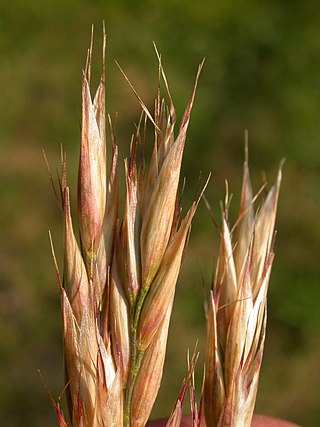
Danthonia is a genus of Eurasian, North African, and American plants in the grass family. Members of this genus are sometimes referred to as oatgrass, but that common name is not restricted to this genus. Other common names include heathgrass and wallaby grass. Australian species have since been reclassified into the genus Rytidosperma.
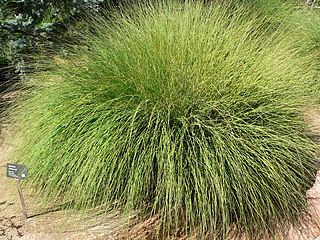
Muhlenbergia is a genus of plants in the grass family.

Melica is a genus of perennial grasses known generally as melic or melic grass. They are found in most temperate regions of the world.
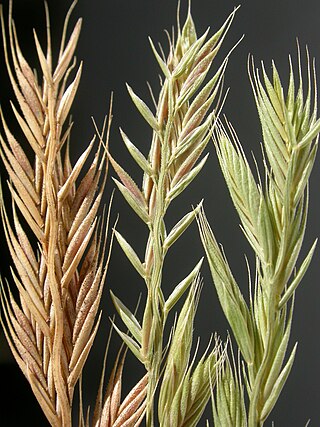
Vulpia is a widespread genus of plants in the grass family, native to many countries around the world and naturalized in many of the nations to which it is not native. It is most common in temperate regions.

Glyceria is a widespread genus of grass family common across Eurasia, Australia, North Africa, and the Americas.

Rostraria is a genus of plants in the grass family, native primarily to Eurasia and North Africa with one species native to South America. Hairgrass is a common name.
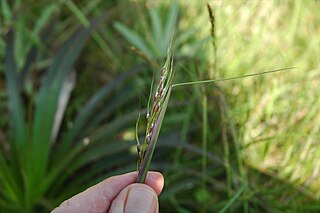
Piptochaetium, or speargrass, is a genus of plants in the grass family, native to North and South America. Piptochaetium is a bunchgrass genus in the tribe Stipeae.
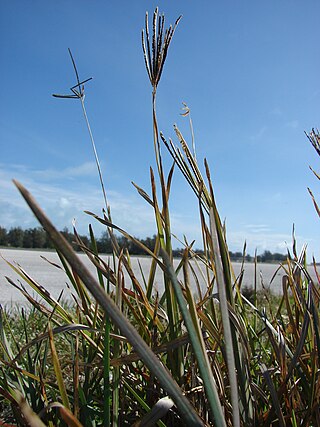
Eustachys is a genus of tropical and subtropical plants in the grass family. It is native primarily to warmer parts of the Americas, with a few species in Africa and Asia.

Coelorachis is a genus of plants in the grass family, widespread across much of Asia, Africa, Australia and the Americas.
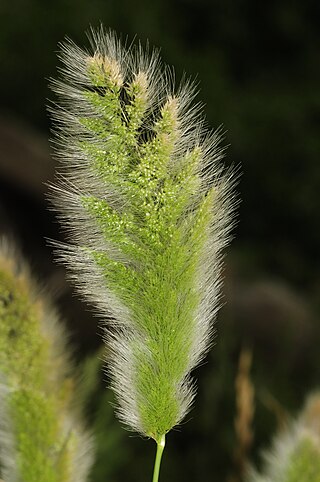
Polypogon monspeliensis, commonly known as annual beard-grass or annual rabbitsfoot grass, is a species of grass. It is native to the Old World, but it can be found today throughout the world as an introduced species and sometimes a noxious weed. It is an annual grass growing to heights between 5 centimeters and one meter. The soft, fluffy inflorescence is a dense, greenish, plumelike panicle, sometimes divided into lobes. The spikelets have long, thin, whitish awns, which give the inflorescence its texture.

Tetrapogon is a genus of grasses.

Chascolytrum is a genus of plants in the grass family, native to Latin America from Mexico to Chile.
Polypogon maritimus, the Mediterranean rabbitsfoot grass, is a species of annual herb in the family Poaceae. They have a self-supporting growth form. Individuals can grow to 0.17 m.

Polypogon viridis, the beardless rabbitsfoot grass, is a species of perennial grass in the family Poaceae. They have a self-supporting growth form and simple, broad leaves. Individuals can grow to 0.43 m. They are native to southern Europe, Macaronesia, North and East Africa, and Asia.



















